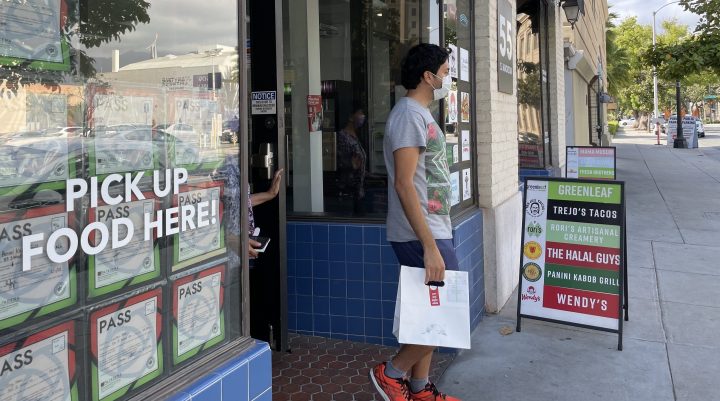
Inside a “ghost kitchen” with Kitchen United

In Pasadena, California, there’s a storefront shared by 25 restaurant brands.
It’s what’s known as a “ghost kitchen” or “virtual kitchen” –– the restaurants operating there fill takeout and delivery orders only.

The company behind it, Kitchen United, owns six facilities like this one, hosting multiple restaurants under one roof with a shared space for customers and delivery drivers to collect orders.
The company also operates an online platform where customers can order from multiple restaurants at the same time. It’s a lot like a food hall, but without anywhere for people to sit and eat.
Michael Montagano, Kitchen United’s chief executive, showed “Marketplace” host Kai Ryssdal around.
“The way we see it, a ghost kitchen is actually just a way for consumers to have choice on how they want to consume their food and provide a tool for restaurant brands large and small to be able to capture that new demand in a capex-light, efficient way,” he said.
Kitchen United provides the basic infrastructure and restaurants, ranging from big national chains like Wendy’s to local, family-owned establishments, staff the cooking spaces inside with their own employees.
“We’re doing the cleaning, sanitization, [and] food receiving … but our restaurant partners are doing the cooking,” said Montagano. “Most of our restaurant brands are able to begin serving within 60 days with less than $10,000 of expenses.”
Montagano told Ryssdal that about 40% of order volume at the Pasadena facility comes through Kitchen United’s online platform, while the rest comes from customers ordering directly from restaurants themselves or third party delivery apps such as Grubhub, Postmates and Doordash to collect takeout orders.
![]()
Employees of the restaurant companies prepare orders and place them on a shelf near where the food is cooked. ![]()
Kitchen United employees take the orders off the shelf and into the pickup center.

In the back, where the restaurants partnering with Kitchen United cook their food, Montagano introduced Ryssdal to Adam Gertler, culinary director for Dog Haus, a fast-casual restaurant chain.
Dog Haus currently has about 50 brick-and-mortar locations across the U.S. and recently launched several virtual brands. “This is like seven restaurants in this very tiny little space, right here,” said Gertler.
These virtual brands –– with names like Bad-Ass Breakfast Burritos and Bad Mutha Clucka –– don’t have physical locations of their own; they operate out of existing Dog Haus locations and ghost kitchens like this one.
“Our original intention was to workshop these for months and months in this facility. But when the pandemic happened, we knew that we were going to have to triple down on the delivery business … and it really helped a lot of our stores stay alive.”

The pandemic dramatically increased demand for takeout and delivery. A recent survey by the National Restaurant Association found that more than half of consumers say takeout and delivery is “essential to the way they live.”
Across the U.S., ghost kitchens facilities are popping up inside vacated retail spaces, hotels, even repurposed parking lots. Kitchen United is bringing its virtual food hall concept to a shopping mall in Santa Clara, California.
Montagano told Ryssdal the company intends to have 20 kitchen centers open by the end of the year. “The dining room is going nowhere,” he said. “What we’re offering is incremental to the volume that restaurant brands are doing out of their four-wall sites.”
There’s a lot happening in the world. Through it all, Marketplace is here for you.
You rely on Marketplace to break down the world’s events and tell you how it affects you in a fact-based, approachable way. We rely on your financial support to keep making that possible.
Your donation today powers the independent journalism that you rely on. For just $5/month, you can help sustain Marketplace so we can keep reporting on the things that matter to you.



















